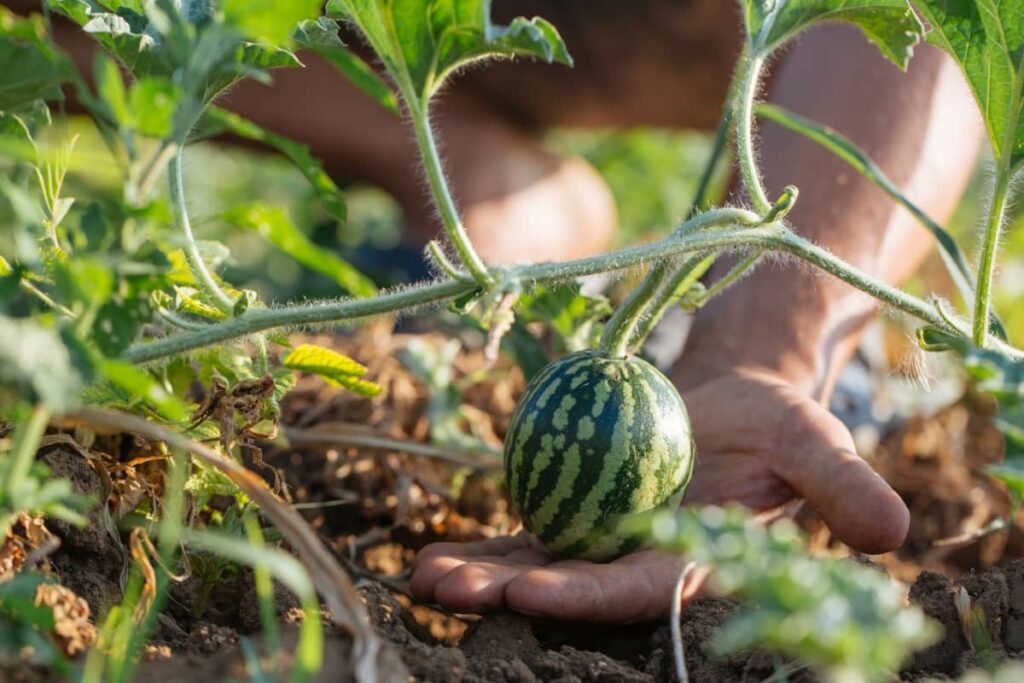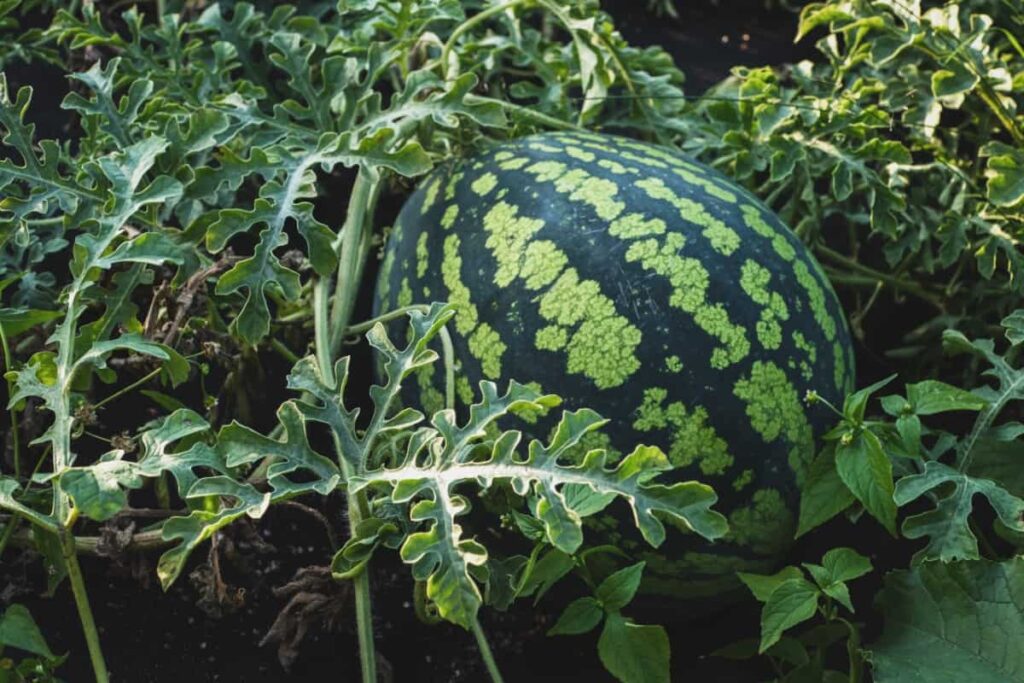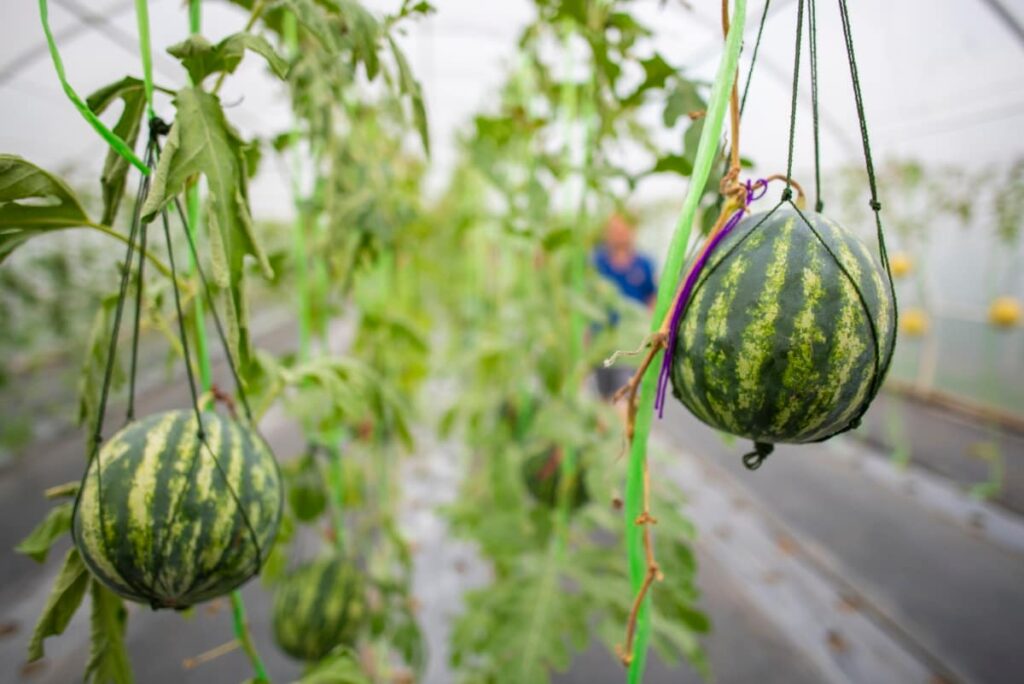Watermelon is scientifically called Citrullus lanatus, and it is a delicious fruit that belongs to the family Cucurbitaceae. Watermelon plants require a balanced supply of essential nutrients to thrive. The importance of fertilizer management in Watermelon lies in its ability to offer essential nutrients that are necessary for the plant’s growth and development.

Watermelon Fertilizer Management
Overview of Nutrient Requirements for Watermelons
Watermelons have specific nutrient needs for optimal growth and development. The primary macronutrients required by Watermelons include nitrogen (N), phosphorus (P), and potassium (K). In addition to these macronutrients, Watermelons also require various micronutrients or trace elements. These include calcium, magnesium, sulfur, iron, manganese, zinc, copper, boron, and molybdenum – all playing vital roles in different physiological processes within the plant.
Understanding Soil Health and Preparation
Testing Soil Nutrient Levels
Before planting, it’s essential to assess the nutrient soil levels to ensure optimal growth and development. There are various methods for testing soil nutrient levels, such as using DIY kits or sending samples to a lab for analysis. Testing soil nutrient levels is just one aspect of preparing healthy soils for growing Watermelons. It complements other important practices, such as proper irrigation techniques and weed control measures.
Amending Soil Before Planting
By amending the soil before planting, you can optimize nutrient availability and create an ideal environment for Watermelon plants to thrive. Common soil amendments include organic matter like compost or well-rotted manure. You may need to adjust the pH level of your soil using lime or sulfur if it falls outside the desired range for Watermelon cultivation (typically between 6.0 and 7.5).
Types of Fertilizers for Watermelons
Organic vs. Synthetic Fertilizers
Organic fertilizers for Watermelon plants are derived from natural sources like compost, manure, bone meal, or fish emulsion. These fertilizers provide slow-release nutrients that feed the plants over time. They improve soil fertilizers and are designed to release nutrients slowly by adding organic matter. On the other hand, synthetic or chemical fertilizers are manufactured using mineral salts or chemicals. They offer a more precise nutrient balance and faster results compared to organic options.
Slow-Release Fertilizers and Their Benefits
Slow-release fertilizers are a popular choice for Watermelon growers due to their many benefits. These fertilizers are designed to release essential nutrients slowly, which helps provide a consistent nutrient supply to the plants. Slow-release fertilizers promote more balanced growth in Watermelons. This leads to healthier plants with improved root development and better fruit set.
Key Nutrients for Watermelon Growth
Nitrogen, Phosphorus, and Potassium (N-P-K) Ratios
Nitrogen is responsible for promoting leafy green growth and enhancing overall plant vigor. Phosphorus aids in root development, energy transfer within the plant, and overall crop maturity. Potassium contributes to disease resistance, stress tolerance, and fruit quality. Applying a balanced N-P-K ratio fertilizer 10-20-10 for Watermelon growth.
Trace Elements and Their Role in Watermelon Development
Trace elements are micronutrients that plants need in small quantities but are still critical for their overall health. These elements include iron (Fe), manganese (Mn), zinc (Zn), copper (Cu), boron (B), molybdenum (Mo), and chlorine (Cl). Each trace element has specific roles in the physiological processes of Watermelons.
In case you missed it: Watermelon Farming Information Guide

Fertilizer Application Schedule
Pre-Planting Fertilization Techniques
To determine the right amount of fertilizer needed for Watermelon, it’s essential to test your soil’s nutrient levels beforehand. Soil testing helps identify any deficiencies or excesses that may exist, allowing you to tailor your fertilization plan accordingly. Different methods of applying fertilizers effectively:
Side-dressing: This method involves placing fertilizer along rows beside growing plants during their active growth phase.
Foliar sprays: Applying liquid fertilizers directly onto leaves allows for quick absorption.
Drip irrigation and fertigation: This technique involves injecting fertilizers into the irrigation system
Fertilizing During the Growing Season
Fertilizing Watermelons during the growing season ensures that your Watermelons receive a steady supply of essential elements for optimal growth and fruit development. During this stage, regular applications of fertilizer for Watermelon can help support healthy foliage growth, strong root development, and increased fruit production. It is important to monitor your plants closely and adjust your Watermelon fertilization schedule practices accordingly.
Methods of Fertilizer Application
Side-Dressing and Foliar Sprays
Side-dressing involves applying fertilizer directly to the soil around the base of the Watermelon plants. This method is typically done once or twice during the growing season based on the specific plant needs. On the other hand, foliar sprays involve spraying liquid fertilizer onto the leaves of Watermelon plants. This method allows for quick absorption through leaf surfaces and direct delivery of nutrients to plant tissues.
Drip Irrigation and Fertigation Techniques
Drip irrigation and fertigation techniques have revolutionized Watermelon cultivation by providing a precise and efficient way to deliver nutrients directly to the plant’s root zone. Fertigation takes advantage of this efficient watering system by incorporating fertilizers into the irrigation process. Liquid or soluble fertilizers are injected into the drip lines, allowing for precise nutrient delivery based on plant needs.
Monitoring and Adjusting Fertilization Practices
Signs of Over-Fertilization and Under-Fertilization
One common sign of over-fertilization in Watermelon is the presence of burnt or scorched foliage. Excessive levels of nutrients, particularly nitrogen, can cause leaf edges to turn brown or black. Additionally, an overly lush appearance with dark green leaves and excessive vegetative growth may indicate an imbalance in nutrient uptake.
On the other hand, under-fertilized Watermelon plants often exhibit stunted growth and pale yellowing leaves. This can be attributed to insufficient nutrient availability necessary for proper development. Regularly monitoring soil conditions through testing is essential for assessing nutrient levels accurately.
Adjusting Fertilization Based on Plant Growth Stages
During the initial stage of plant growth, known as the vegetative stage, Watermelon plants focus on developing a strong root system and lush green foliage. To support this phase, nitrogen-rich fertilizers are typically applied. As Watermelons approach maturity during the ripening stage, fertilizer applications should be adjusted accordingly once again.
Organic Fertilization Options
Using Compost and Manure
Compost, which is made from decomposed organic matter such as vegetable scraps, leaves, and grass clippings, is rich in nutrients that promote healthy plant growth. Manure from animals like cows or chickens is another valuable organic fertilizer option for Watermelons. To use manure as an organic fertilizer for Watermelons effectively, mix well-aged or composted manure into the soil several weeks before planting.
Green Manures and Cover Crops
Green Manures and Cover Crops play a vital role in Watermelon cultivation by improving soil health and fertility. These are essentially crops that are grown specifically to be turned back into the soil, providing valuable nutrients and organic matter. Cover crops like rye grass or buckwheat can also be utilized for their ability to scavenge excess nutrients from the soil. This prevents the leaching of nutrients into groundwater or runoff into nearby bodies of water.
Watermelon Plant Care and Maintenance
Watering Practices in Relation to Fertilization
Proper watering is important for healthy plant growth, especially when it comes to nutrient uptake. The key is to strike a balance between providing enough moisture for the plant’s needs and avoiding overwatering, which can leach nutrients from the soil. When it comes to watering Watermelons, consistency is key. It’s important to maintain evenly moist soil throughout the growing season.
Weed Control and Mulching
Weeds compete with Watermelons for nutrients, sunlight, and water, hindering their growth. To combat this issue, mulching is an effective technique that not only controls weeds but also helps retain moisture in the soil. Mulching involves covering the surface around Watermelon plants with an organic material layer such as straw or wood chips.
In case you missed it: How to Grow Watermelon Faster: Best Tips to increase Flowering, Fruiting, and Production Yield

Troubleshooting Common Nutrient Deficiencies
Identifying Symptoms of Nutrient Shortages
One common nutrient deficiency in Watermelons is nitrogen (N) deficiency. This often manifests as pale green or yellow leaves starting from the plant bottom and progressing upwards. In severe cases, plants may exhibit stunted growth and reduced fruit production. A phosphorus deficiency may cause purplish discoloration on older leaves and slow overall growth. Potassium (K) deficiency is also common in Watermelons and results in weak stems and poor fruit quality.
Corrective Measures for Nutrient Deficiencies
- Nitrogen deficiency: This often manifests as pale-yellow leaves with stunted growth. To remedy nitrogen deficiency, apply a nitrogen-rich fertilizer such as ammonium sulfate or urea according to label instructions.
- Phosphorus deficiency: Symptoms include dark green leaves with purple discoloration and poor fruit development. Add phosphorus-rich fertilizers like bone meal or rock phosphate around the base of the plant.
- Potassium deficiency: Look out for yellowing leaf margins, weak stems, and reduced fruit quality. Apply potassium sulfate or potassium nitrate to address this deficiency.
- Iron deficiency: Yellowing between leaf veins indicates iron-deficient plants, known as chlorosis; treat it by applying iron chelate solutions directly to the foliage or using iron-enriched fertilizers.
In case you missed it: Watermelon Farming in the Philippines: How to Plant and Grow for Profits

Conclusion
Fertilizer plays an important role in Watermelon development, ensuring they reach their full size, flavor, and overall quality. Fertilizer management in Watermelon is a crucial aspect of cultivating this juicy and delicious fruit.
- Sheep Farming Business Plan for Beginners
- Aquaponic Farming at Home: A Step-By-Step Guide
- Profitable Village Farming Business Ideas in 2024
- High-Yield Aquaculture: Fast-Growing Fish for Farming
- Effective Fish Pond Construction Techniques for Beginners
- Irrigation and Water Management in Pineapple Farming
- Blossom to Harvest: Mastering Flowering and Pollination in Papaya Farming
- Pig Fattening Essentials: From Selection to Sale for Beginners
- Raising Wagyu Cattle: A Complete Guide for Premium Beef Production
